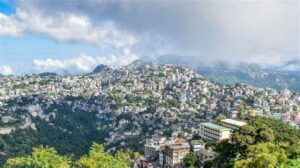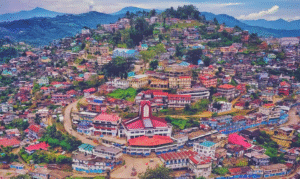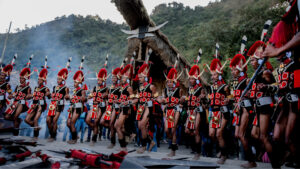Nestled in the mist‑wrapped hills of Serchhip District, near Thenzawl town, lies Vantawng Falls, locally known as Vantawng Khawhthla. Cascading a total of approximately 228.6 m (750 ft) in a mesmerizing two-tiered spectacle over the Vanva River, it stands as the tallest uninterrupted waterfall in Mizoram and ranks within India’s top 15 by height . This blog delves deep into its formation, folklore, ecological significance, tourism role, and sustainable management.
Geology and Geomorphology
Tectonic and Topographic Setting
Mizoram is typified by the folded terrain of the Lushai Hills—a southern extension of the Indo‑Myanmar ranges—formed due to the collision of the Indian and Burma plates. These tectonic processes have sculpted steep, highly eroded hills, intersected by deep valleys and fast-flowing streams.
Vantawng Falls develops as the Vanva River enacts its course through resistant rock strata, dropping sharply over vertical cliff faces created by differential erosion, characteristic of the region’s geology .
Two‑Tiered Structure
The waterfall is distinctly tiered: an upper drop plunging into an intermediate pool, followed by a second descent to the valley floor. This multi-stage geometry is a common trait in waterfalls chain-reacted along rivers with variable lithology and erosional resistance .
Folklore and Cultural Memory
Origin of the Name
The falls are named after Vantawnga, a legendary local swimmer famed for dancing in the torrents like a fish. Tragically, his life was cut short when a drifting log struck him mid‑performance, and the falls became his namesake .
This narrative weaves people and landscapes together, blending the dramatic topography with cultural storytelling.
Socio‑Cultural Context
Within Mizo custom, natural landmarks like waterfalls often accrue spiritual and communal significance. Folkloric narratives frequently embed moral lessons—here, the tale of Vantawnga may symbolize caution against nature’s unpredictability even in moments of triumph.
The falls also play a role in local seasonal rituals and community gathering during festivals like Chapchar Kut, reinforcing their cultural relevance .
Ecological Significance
Micro‑Climate and Vegetation
Vantawng’s spray zone and mist create a cool, humid micro‑climate, nurturing diverse mosses, ferns, and shade‑tolerant plants adjacent to the falls. The surrounding hills are blanketed by semi‑evergreen forests and bamboo thickets, typical of Mizoram’s mid‑hill moist ecosystems (capertravelindia.com).
Biodiversity Hotspot
While systematic biodiversity inventories around Vantawng are awaited, Mizoram generally supports over 150 bird species—like Mrs. Hume’s pheasant—and mammals such as hoolock gibbon and clouded leopard, especially in protected zones like Phawngpui and Dampa (en.wikipedia.org).
Riparian zones around waterfalls are critical for amphibians and insect life, contributing substantially to both local ecological health and larger watershed systems.
Cultural Landscape & Tourism
Proximity and Accessibility
Located just 5 km south of Thenzawl and about 92–100 km from Aizawl (depending on route), reaching the falls takes roughly 3–4 hours by road .
Despite narrow roads near the viewpoint creating occasional vehicular bottlenecks, the site is accessible year-round. A constructed viewing tower ensures safe observation of the falls while minimizing ecological disturbance .
Visitor Experience
Best Viewing Times
- Post‑Monsoon (September–January): stronger flows and clearer skies .
- Summer and early winter: moderate flow; still visually captivating .
Entry to the site is nominal (INR 5 at last reported).
Complementary Attractions
Nearby Tuirihiau Falls, just upstream, offers a unique cave‑stream experience, where visitors can literally stand behind the cascading sheet of water.
Visitors often extend their itinerary to include Thenzawl Golf Course and Resort, Thenzawl Deer Park, and caves like the ancient Mura Puk, enhancing ecological tourism.
Infrastructure Developments
Existing Facilities
- Viewing Tower: Provides vantage points, protects forests from uncontrolled access .
- Tourist Lodging: Limited options near Thenzawl and Serchhip; capacity is small but sufficient for current visitor number.
- Cafés and Roadside Eateries: Basic food and refreshment facilities in the vicinity .
Future Plans
In line with Mizoram’s “Peaceful City” master‑plan, the district government is exploring additional infrastructure, including potential ropeways to improve access while mitigating ecological impact.
Strategic investments are targeting homestays and visitor centers, reflecting growing emphasis on community-based and eco-sensitive tourism.
Conservation and Challenges
Environmental Pressures
- Erosion & Landslides: The monsoon-fed region is prone to landsliding, which may destabilize roads and hiking trails near the falls.
- Tourist Impact: While visitor numbers remain moderate, improper waste disposal, trampling of vegetation, and disturbance to wildlife could escalate as tourism grows.
Regulatory Framework
Mizoram’s Department of Environment and Forests categorizes site development under a managed eco-tourism model. Tourist fees are kept low; entry to the falls is regulated to prevent overcrowding .
Local NGOs and authorities have begun planning tree-planting drives, trail demarcation, and cleanup campaigns to preserve the area’s ecological integrity.
Myth vs. Modernity: Navigating Landscape Narratives
Embedded in Cultural Memory
Vantawnga’s story powerfully ties human narrative to natural formations. These localized mythologies foster stewardship by connecting community identity to landscape preservation.
Contemporary Interpretation
Today, the falls are more than folklore landmarks—they are seen as assets for eco-tourism, environmental education, and community livelihood. Yet this shift triggers tension: how does one balance mythic respect with developing amenities like tents, ropeways, and cafés? Finding a path that honors intangible heritage and ecological health remains vital.
Academic and Educational Role
Interdisciplinary Learning Site
Vantawng Falls is a prime case for academic exploration in:
- Physical Geography: Understanding waterfall formation, erosional patterns, and hydrology.
- Ecology: Studying humidity-sensitive vegetation, wildlife habitat, and watershed dynamics.
- Anthropology & Folklore: Analysing Mizo storytelling traditions and place‑making.
- Sustainable Tourism: Examining community-driven models and minimal-impact site planning.
Field Studies and Documentation
The region remains under-documented academically. Universities and students can contribute by:
- Conducting floristic surveys of waterfall micro-environments.
- Monitoring water quality across seasons.
- Recording oral histories connected to Vantawnga and survey upstream/downstream cultural features.
- Evaluating socio-economic impacts of tourism on Thenzawl and Serchhip communities.
Conclusion and the Way Ahead
Vantawng Falls embodies the intersection of natural grandeur, cultural narrative, and evolving tourism. Strategically protecting its physical and mythic heritage while accommodating growth requires collaborative stewardship. Recommendations include:
- Community Engagement: Involve local stakeholders in planning, interpretation, and revenue sharing.
- Low‑Impact Pathways: Incorporate ropeways, boardwalks, and trails to prevent ecological disturbance.
- Education Hubs: Establish interpretive centers that integrate geology, ecology, and folklore.
- Scientific Research: Promote collaborative documentation and monitoring across disciplines.
- Holistic Planning: Integrate Vantawng with wider regional tourism (Tuirihiau, deer park, golf resort, caves) to diversify value while dispersing visitor pressure.
By weaving scientific insight, ecological preservation, cultural respect, and sustainable infrastructure, Mizoram can preserve Vantawng Falls as a living, breathing tapestry of natural and human heritage—shaping its identity well into the future.
Final Thoughts
Vantawng Falls offers more than visual splendor—it invites us to reflect on the delicate union of geology, ecology, culture, and responsible tourism. As climate change, infrastructure expansion, and visitor interest evolve, so too must our approaches to preservation. By embedding academic insight, local wisdom, and sustainable design into its future, Vantawng Falls can become an exemplar of heritage conservation and eco‑education in northeastern India.
As educators, scholars, policy-makers, and eco-travelers, we carry a collective responsibility: to embrace Vantawng Falls not merely as a destination, but as a living classroom and cultural tapestry—one that enriches our understanding and inspires its protection for generations ahead.






